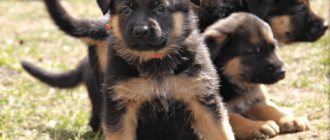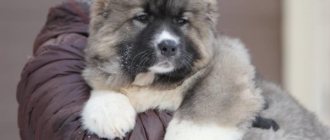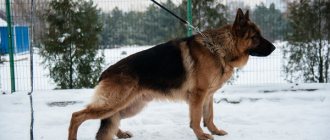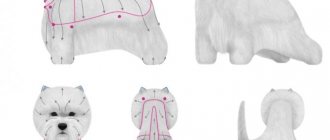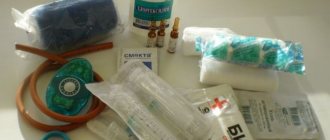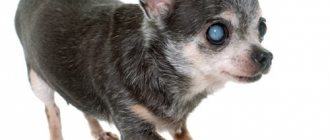Features of the position
Dog pregnancy is a delicate period. Caring for your pet includes regular visits to the veterinarian and good hygiene. At the same time, the dog owner needs to become familiar with the physiological features of the process in as much detail as possible. Thus, you will not worry in vain, and at the right time you will be able to come to the aid of your pet.
As a rule, it is quite difficult to diagnose pregnancy in a dog in the early stages. During the first month after a successful mating, no visible symptoms are detected. It would seem that there is nothing unusual in the pet’s behavior. However, after this period, you will be able to identify the following changes in the animal’s behavior:
- the dog eats dry food in large quantities, drinks a lot of water, constantly rests and generally becomes much calmer;
- the expectant mother’s belly gradually becomes rounder and she gains significant weight;
- the dog's average body temperature decreases;
- Enlargement of the external genital organs is noticeable to the naked eye. At the same time, watch your pet, because a few weeks before giving birth she will begin to have characteristic mucous discharge from the loop, she may tremble;
- When there is no more than a day left before the birth, the expectant mother, as a rule, loses her appetite and breathes heavily.
Find out how to care for your pet during this difficult period for her (what to feed and how often to bathe), and then you can properly prepare both the dog and yourself for childbirth.
How to cut a pregnant bitch's hair
Since 2-3 months after giving birth the bitch gradually sheds her old hair and grows new hair, a long-haired dog can even be trimmed slightly. In the last days before whelping, you should cut off excess hair near the nipples, as it gets dirty with the secreted colostrum, and when feeding the puppies, it becomes tangled. The hair around the bitch's external genitalia is also trimmed (unless, of course, it is very long) so that the puppies do not get tangled in it at birth.
Hygiene procedures
The first thing to remember when you have a pregnant dog in your home is the importance of being stress-free for the expectant mother. Even the next bath in the bathroom can turn into a real test for a dog: it becomes too sensitive and reacts sharply to the slightest stress. This is why many experts recommend stopping bathing from the fifth week of a dog’s pregnancy. And it’s not just a matter of the pet’s nervousness - after another such hygienic procedure, she can become hypothermic and get sick.
If you decide to regularly bathe your pregnant dog, be sure to close the windows in the house before the procedure and avoid the slightest drafts. At the same time, do not forget to thoroughly dry the coat of the expectant mother after washing. Another important point: if you just bathed your pet, try not to take her outside for 24 hours. In this way, you will prevent the expectant mother from getting a cold.
Hygiene procedures also include regular cleaning of the ears and teeth of a pregnant dog. From time to time, remove plaque from the surface of your teeth, and also clean your ear canals. In this case, you will remove bacteria and contaminants at the right time.
How to determine pregnancy
It is recommended to show the bitch to a veterinarian 25-35 days after fertilization. During this period, the following diagnostic methods are most effective:
- Palpation . By palpation, pregnancy can be determined between 21 and 35 days. The veterinarian can feel the individual sacs of fluid in which the embryos develop. At later stages, the uterus becomes more flexible, and the sacs cannot be felt.
- Ultrasound of the abdominal cavity . An ultrasound examination 100% confirms pregnancy, establishes its duration, and determines the viability of the fetus.
- Hormonal test . To confirm pregnancy with a hormonal test, it is performed at 30 days or later. Testing earlier may show a false negative result.
Another diagnostic test is radiography. This is an effective way to determine the number of puppies. It is carried out from 42 to 55 days after mating.
Pet diet
What to feed an adult pregnant dog is another point that requires detailed clarification. A well-designed diet will have a beneficial effect on your pet’s well-being. In addition, if she receives all the necessary vitamins along with food, she will become much stronger and prepare for the upcoming birth.
It is believed that feeding a dog in early pregnancy should not differ in any way from its usual regimen. However, over time, you will need to include various vitamins for your pregnant dog in your daily diet. Starting from the third week, try to control the intensity of weight gain by your four-legged pet. If she is gaining too much weight, it is better to limit the daily menu a little. Otherwise, it will bristle with great difficulty.
Add milk porridge, cottage cheese, raw meat, as well as boiled liver and chopped vegetables to your diet. It is strictly forbidden to give a expectant mother raw cabbage, which promotes the active release of gases and causes diarrhea. The frequency of feedings is equally important. In the second month of pregnancy, it is recommended to switch the dog to three meals a day, and after seven weeks - to four meals a day.
Diet during pregnancy
A lot depends on how you feed your pregnant pet: the health of the puppies, the well-being of the expectant mother and, of course, the functioning of her internal organs.
- Don't let your dog eat food today that you prepared yesterday. All food should be as fresh as possible, especially meat dishes. Food poisoning is scary not only because of the disgusting health of the pet, but also because of the death of the babies.
- Be prepared for the fact that your pet’s tastes will change dramatically: there is nothing to worry about, because a pregnant woman also often radically changes her preferences. The mechanism is the same here.
- If you prefer natural food, be sure to purchase special vitamins on the recommendation of your veterinarian. If you have made a choice in favor of dry food, then additional complexes are not needed (only in the case of special doctor’s prescriptions), otherwise this can lead to the development of various pathologies.
- Do not increase the portion of food in the first 5 weeks of pregnancy, but provide liquid so that the pet does not need it at any time of the day. Already in the second half of gestation, the total number of calories consumed per day can be increased by about 25-30%.
- In the second half of pregnancy, it is important to increase the number of feedings per day from 2 to 5 times, but the portions themselves will have to be reduced somewhat, otherwise regurgitation may occur.
Getting rid of parasites
Is it possible to worm a pregnant dog without consequences? This is a question dog breeders often face. In fact, it is allowed to resort to such a procedure during the first three weeks after mating. If you did not manage to remove worms from the body of the expectant mother in a timely manner, refuse treatment in the future. Otherwise, you risk losing your puppies.
Be sure to consult your veterinarian before deworming. He will tell you which medications to choose for a pregnant dog. Remember that you can safely deworm only in the early stages of pregnancy of your four-legged pet.
How long does pregnancy last in dogs?
The period of gestation of offspring is individual for each female. It is impossible to reliably know how long a pregnancy lasts - even for the same female, each pregnancy can have a different duration.
On average, a dog bears offspring for 8-10 weeks, from 53 to 70 days.
Puppies born before 53 days may have difficulty opening their lungs. Those born after 70 days often experience hypoxia and intoxication of the body.
What affects the term
The duration of pregnancy is affected by:
- age of the bitch;
- number of embryos;
- size and breed of dog;
- general health of the pregnant bitch.
If there are many puppies in the litter, the gestation period is reduced. Childbirth may occur several days earlier than the expected date. Also, premature birth often occurs in dogs with hidden health pathologies, too young and elderly dogs.
How many months does pregnancy last?
Dogs of small and miniature breeds – 2 months (60 days).
Large and giant breeds – 2 – 2.5 months (63-70 days).
Important!
If the pregnancy is approaching the 70th day, there is a risk of carrying the offspring. Be sure to take your dog to the veterinarian so that he can decide whether labor or caesarean section is necessary.
First pregnancy - how to prepare a dog
A dog's first pregnancy is an exciting and worrying period for its owner.
The dog must be prepared in advance for this event.
- Conduct all necessary vaccinations and check the health of the expectant mother. The veterinarian will tell you whether the animal is ready to bear offspring and check whether there are any contraindications for this.
- Treat the animal against external and internal parasites. This can be done during pregnancy, but it is better to take care in advance.
- 3-4 months before the planned mating, the dog is switched to a high-quality balanced diet and increased physical activity to get rid of excess fat deposits and strengthen muscles.
During the entire period of gestation, it is necessary to carefully monitor the dog’s condition, conduct regular examinations (tests, ultrasound), and follow all the veterinarian’s recommendations for care and feeding.
Related care activities
Physical activity will also have to be reconsidered. In the first half of pregnancy, it is allowed to continue training or regular work, if available. Closer to a significant event, it is recommended to reduce the load, long walks and active games, give the bitch the opportunity to rest more. Protect from contact with other people's dogs, especially males.
In advance (about 10 days in advance), prepare a place with new bedding that is comfortable for sleeping, and subsequently for childbirth. Choose a secluded corner so that the animal feels protected even after producing offspring. In winter, you should not leave a pregnant dog outside, just like in hot weather. The optimal temperature for her and the puppies should be approximately + 24.5 degrees.
Try to protect the expectant mother from all kinds of stress. Subsequently, this will affect the puppies, even their mental abilities.
If possible, use the services of a veterinarian so that a specialist can monitor how the pregnancy progresses throughout the entire period. It is advisable to have a veterinary station nearby in case of unforeseen complications.
In the middle of the term, toxicosis may occur. She, like a person, can feel sick. Then the dog eats very little or refuses to eat at all. In such cases, you should not force it. Eliminate foods that, based on your observations, can cause negative changes in the dog’s body. Better yet, just be patient for a few days, and your appetite will return with the disappearance of toxicosis. If the dog's condition does not change, veterinary attention is needed.
The physiological characteristics of this period are characterized by increased urination. You are required to take care of more frequent walks, protecting the animal from communicating with other brothers.
There are cases when pregnancy turned out to be false. Beginning its development, the fetus engages certain functions of the body, and its work continues while the embryos have disappeared at an early stage. That is, all the signs of pregnancy appear, which in fact does not exist. The only correct way out in this situation is to contact a veterinarian. You need to consult a specialist about anthelmintics, since after three weeks of pregnancy it is mandatory to carry out deworming. For this purpose, special preparations are sold that do not harm the future offspring.
Do not let the process of physiological change in the state of one of the family members take its course; even this animal is empty. Several weeks of increased attention to a pregnant dog and proper care for it will be rewarded with newborn puppies - an exact copy of your pet as a child.
Is it possible to give a dog cat food?
Pleasant chores for a pregnant dog
And the chores are really pleasant. After all, you are warmed by the thought that the baby you once chose will thank its owner for the patience and affection shown to him for a long time. And as a gift - puppies of your favorite breed, which, by the way, determines the exact duration of pregnancy and its characteristics. It’s a paradox, but a dog’s litter is also affected by its size. Large bitches bring fewer puppies, but small mothers can generously give up to fifteen cubs. The owner must be prepared for the birth process in advance, since the offspring can be quite large. If the conditions for keeping the dog are unfavorable and there is no proper care, there is a possibility of losing the offspring and the mother.
how to care for a pregnant cat
Which dogs should not be cut?
Separately, it is worth considering the question of which dogs should not be cut. This group includes representatives of certain breeds for which such a procedure is contraindicated.
Important! If the owner does not know for sure whether dogs can be groomed, then he should ask this question to an experienced specialist.
Here are some dogs that should not be cut:
- Retweaver.
- Husky.
- Malamute.
- Labrador.
The list can also include short-haired breeds, as well as dogs with a thick undercoat. After a haircut, it may stop growing fully.
Who should be trimmed?
Irina Portnova. Photo courtesy of Irina Portnova
It is recommended to trim dogs of wire-haired breeds. Such dogs were bred specifically for hunting, so their coat perfectly protects the animal from cold and dirt, thanks to its structure - soft undercoat and hard guard hairs. It is precisely in order for the fur to retain its original structure that it is necessary to trim the animal.
Features of caring for a puppy bitch
First of all, responsibility for the health of the mother and future puppies lies on the shoulders of the owner. It is important to provide the bitch with comfortable conditions and moderate temperature conditions. Provide her with all the necessary minerals and vitamins, monitor her weight, body temperature and general condition.
Nutrition for a pregnant dog
Before giving birth, it is important to reduce the fat layer, so the dog is switched to a balanced diet. , the female needs additional bait, including calcium and vitamin C. If the breed is prone to joint diseases, the diet must contain vitamin D and phosphorus . Before introducing bait, you should consult a veterinarian to find out your predisposition to allergies.
The choice of food can be either ready-made or natural. It depends on what the pet is used to. Dry food is selected taking into account pregnancy; many companies produce specialized food.
The natural menu must include the following products:
- Boiled lamb, veal, rabbit;
- Rice and buckwheat porridge;
- Low-fat kefir or cottage cheese;
- Quail eggs 2 times a week;
- Fresh fruits and vegetables (apple, carrots).
During pregnancy, it is especially important to avoid eating low-quality or inappropriate foods. It is worth giving up chicken, fish, and limiting the consumption of potatoes and cereals. 30 days after fertilization, liquid vitamin E (1 drop per day).
By 5-7 weeks the female is switched to frequent feeding . Usually, this is 4-5 times half a standard portion. By days 50-53, meat and calcium are removed from the diet. It is important to monitor the weight of the expectant mother; the fat layer should not thicken, this will complicate the birth process.
Walking and physical activity
Yes, a pregnant female needs peace; she is limited in communication with noisy, active children and other pets. We must ensure that the girl does not run up the steps, gets injured, or overexerts herself. But you can’t completely remove walks from your daily routine. Not only will moderate physical activity help maintain your pet’s weight and shape, but the sun’s rays that the dog receives during walks have a beneficial effect on metabolism and psychological state.
Every day, expectant mothers are taken for a walk half an hour after eating. Ideally – 30-35 minutes until slightly tired. Large breeds are trained a little more intensely. Often girls are stubborn and do not want to be trained. The owner needs to understand that this behavior is caused by hormonal changes.
The bitch is not allowed to lie on the cold floor, concrete slabs, or wet grass. During pregnancy, it is better to take even street pets into the house and provide them with a spacious, soft place.
Hygiene features
As a rule, pregnant and nursing mothers try not to bathe in order to avoid even the slightest stress . But if the need arises, it is important to choose hypoallergenic shampoos. After water procedures, the wool is thoroughly dried, drafts are avoided.
The most important rule of care is washing your paws after every walk. It is best to do this with a solution of manganese or a weak antiseptic.
Vaccination and disinfestation
Pregnant and nursing mothers cannot be vaccinated. It is best to do this 1-2 days before estrus or just before mating. If during this period the owner did not have time to vaccinate the dog, then the procedure can be carried out only in the 2nd month after the birth of the puppies, when the milk runs out.
Worms are transmitted through the placenta from mother to embryo, which is why puppies are born infected. To avoid this, 2 weeks before mating, the female and male are cleared of helminths. Prevention can be carried out during pregnancy, but use drugs that do not contain pyrethroids and organophosphates. It is better to consult a veterinarian.
General recommendations and approaching labor
Like pregnant girls, dogs can be capricious, picky, and angry. The owner must understand this, take care of the pet, give her affection and love. During childbirth, it is important to reassure and support the female, and if complications arise, immediately take her to a veterinary clinic.
If the dog is weakened or feigns an attack of ill health, it must be properly lifted, calmed and moved to a safe, warm place:
- They take the girl under the breast and under the pelvis, but do not touch the stomach;
- In the room, the dog is placed on 4 paws; if the animal stands on its own, then an examination is carried out (the presence of shortness of breath is noted, the temperature is measured);
- If the indicators are normal and the female is standing and moving, then the pet simply needs more affection and attention; otherwise, it is better to make an appointment with the veterinarian.
The attending physician is selected in advance or in the first weeks of pregnancy. You need to be sure that it can help with exacerbation of any diseases or premature birth. A good veterinarian will help you keep records of pregnancy and give recommendations on keeping your pet.
The approach of labor is determined by the characteristic white discharge - peeling of the mucus plug. A decrease in temperature indicates that there is less than a day left, at which time the female becomes active, can rush around, dig furniture and carpets. Within a few hours, the girl will begin to go to the toilet frequently and do squats.
You need to prepare in advance everything you will need during the birth process:
- A box, a comfortable playpen, from which the puppies cannot get out;
- Rubber diaper (for bedding during childbirth);
- Bandages and gauze for wiping puppies;
- Hand antiseptics (iodine, alcohol, brilliant green);
- Scissors with rounded ends and threads (medical sterile) for the umbilical cord;
- Notepad and scales (for recording time of birth and weight);
- Oxytocion (in the required dose, discussed with the veterinarian) as a last resort measure to stimulate contractions;
- Goat's milk (for feeding newborns in the absence of milk from the mother);
- Broth (for feeding the bitch);
- Hot water bottle (to maintain the temperature of the puppies if the mother has to be taken away).
If a dog is trimmed in a salon by a professional, do you need to do anything with the hair at home?
Rolling is a type of trimming. This is layer-by-layer plucking of wool to maintain shape throughout the entire exhibition season.
Yes, we should. It is necessary to comb out the undercoat by stripping or trimming (the master should advise which tools to buy).
If necessary, the dog needs to be washed - as a rule, this is not necessary often, because the coat of wire-haired dogs itself protects itself from dirt. Naturally, it is necessary to wash with special shampoos and conditioners. After washing, the wool should be dried.
Owners also need to learn how to comb out tangles. Especially owners of dog breeds with so-called decorative hair - miniatures, Scotch terriers.
Preparing for the birth of puppies
The birth of puppies should take place in the most comfortable conditions for the dog. To do this, you need to find a quiet, calm place in advance where there will be no drafts. Install a box or box there. Train your dog to this place in advance so that at the beginning of labor she will come here on her own. Lay a soft natural fabric - an old towel or sheet - on the bottom of the box, and place a disposable diaper on top. This will help keep the area clean after your dog has finished giving birth.
With the advent of offspring and childbirth, animals manage independently. However, you need to be prepared in case something goes wrong. Here is a list of things you need to prepare in advance:
- dry, clean towels for cleaning puppies;
- paper towels for cleaning;
- thermometer to check the dog's temperature before whelping;
- unwaxed dental floss to tie umbilical cords;
- clean scissors to cut the umbilical cord;
- a heating pad to maintain the optimal temperature in the box after the puppies are born;
- iodine for cleaning the abdominal cavity of puppies after cutting the umbilical cord;
- scales.
Keep these items in a clean and easily accessible place.
As whelping time approaches, watch for warning signs in your dog. This may include loss of appetite, “nesting” (the dog carries soft things or newspapers to the same place, arranging a bed there), increased breathing and even a drop in temperature.
Pathologies of pregnancy
Pregnancy does not always end in childbirth. In some cases, this process may be interrupted or not take place at all due to improper fertilization, infections, or genetic reasons.
Frozen pregnancy
Characterized by the fact that one or more embryos (puppies) stop growing and developing. Most often occurs at 3 or 7-8 weeks. The dog’s body can independently get rid of frozen fetuses by resorption of the embryo, miscarriage, or mummification of the embryo with its subsequent decomposition.
If a dog miscarries, it must be taken to a veterinarian to make sure there are no fragments left in the bitch's body. Miscarriage can be partial - viable puppies remain in the uterus. In a complete miscarriage, the entire offspring dies.
Ectopic pregnancy
Cases of ectopic pregnancy are caused by pathologies of the reproductive and endocrine systems. Also, a similar condition can occur due to injuries in the abdominal area, when the walls of the uterus rupture and the embryo enters the abdominal cavity. The condition is manifested by pain, internal and external bleeding and discharge from the female genitals. The ectopic pregnancy is terminated.
